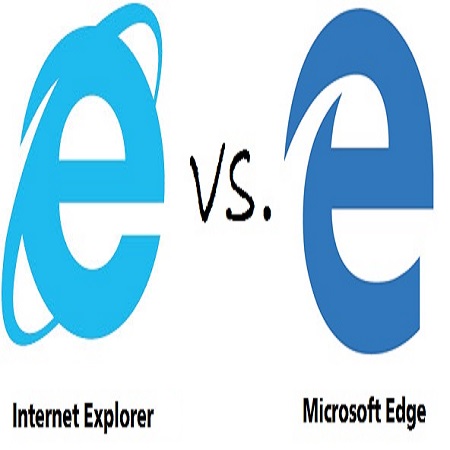Open Internet Explorer sites on Microsoft Edge. On Windows 10, Microsoft Edge also lets you configure the browser so that when someone is using Internet Explorer incompatible or all sites will load within Edge. To let IE open websites with Edge, use these steps: Open Microsoft Edge on Windows 10. Dec 21, 2020 The first time an Internet Explorer mode tab is created in a Microsoft Edge session, all matching cookies are shared to the Internet Explorer session. Subsequently, any time a cookie that matches a rule is added, deleted, or modified it is sent as an update to the Internet Explorer session.
- How To Convert Microsoft Edge To Internet Explorer
- Switch From Microsoft Edge To Internet Explorer
- Microsoft Edge Internet Explorer Mode
Alongside all the features and improvements in the roadmap for the new version of Microsoft Edge based on the Chromium engine, Microsoft includes a compatibility mode using the Internet Explorer rendering engine to load old websites.
The feature is known as “IE Mode,” and it has been designed for organizations to load internal sites without using a separate browser or having to redesign the site. The new approach loads the pages within Microsoft Edge like a regular website without using and managing multiple browsers.
If you want to start using it, the version of Microsoft Edge available through the stable channel now includes the “Internet Explorer compatibilities” settings to quickly enable IE Mode and a separate option to open Edge when browsing an incomparable website with Internet Explorer. Alongside the settings, it also possible to use the Group Policy Editor to configure the compatibility mode.
In this guide, you will learn the steps to enable IE Mode to load legacy websites using the Internet Explorer rendering engine on Chromium Edge for Windows 10. (You can also watch this video tutorial to configure the feature.)
How to enable IE mode on Microsoft Edge
To enable IE mode on Edge, use these steps:
How To Convert Microsoft Edge To Internet Explorer
Open Microsoft Edge on Windows 10.
Click the Settings and More (ellipsis) button on the top-right corner.
Select the Settings option.
Click on Default browser.
Under the “Internet Explorer compatibility” section, turn on the “Allow sites to be reloaded in Internet Explorer mode” toggle switch.
Click the Restart button.
Once you complete the steps, when sites require Internet Explorer, you can use Microsoft Edge to reload the page using IE mode.
Open site with IE Mode on Edge
After the IE Mode is enabled, you need to reload a page with the compatibility mode manually.
To open an incompatible website with IE Mode on Edge, use these steps:
Open Microsoft Edge on Windows 10.
Click the Settings and More (ellipsis) button on the top-right corner.
Select the More tools submenu and choose the “Reload in Internet Explorer mode” option.
After you complete the steps, the website should reload in compatibility mode. If the feature is not enabled, then the option won’t be available in the menu.

If you want to exit IE Mode, you can use the same instructions, but on step No. 3, select the Exit Internet Explorer mode option.
Open Internet Explorer sites on Microsoft Edge
On Windows 10, Microsoft Edge also lets you configure the browser so that when someone is using Internet Explorer incompatible or all sites will load within Edge.
To let IE open websites with Edge, use these steps:
Open Microsoft Edge on Windows 10.
Click the Settings and More (ellipsis) button on the top-right corner.
Select the Settings option.
Click on Default browser.
Under the “Internet Explorer compatibility” section, use the “Let Internet Explorer open sites in Microsoft Edge” drop-down menu and select the option to handle browsing when using Internet Explorer, including:
- Never – IE will never switch to Edge to load the site.
- Incompatible sites only – IE will still load sites, but websites designed for a modern browser will load in Edge.
- Always – IE will always switch to Edge to load websites.
Once you complete the steps, when surfing the web in Internet Explorer, websites will open on Microsoft Edge, according to your configuration.
How to enable IE mode with Group Policy on Microsoft Edge
Alternatively, you can also enable IE Mode on Chromium Edge with Group Policy. However, you will need to download and install the policy template before you can configure the Group Policy settings.
Install Microsoft Edge policy template
To install the policy template to enable IE Mode on Edge, use these steps:
Open Microsoft Edge for business website.
Under the “Policy File” section, click the Download button.
Select the version of Microsoft Edge. (Usually, you want to use the latest stable version available.)
Select the build (latest version available).
Select the platform — for example, Windows 64-bit.
Click the Get policy files option.
Click the Accept & download button.
Double-click to open the MicrosoftEdgePolicyTemplates.zip file.
Click the Extract all button from the “Compressed Folder Tools” tab.
(Optional) Select the location to extract the files.
Check the Show extracted files when complete option.
Click the Extract button.
Browse the following path inside the (extracted) “MicrosoftEdgePolicyTemplates” folder:
Select the msedge.admx and msedgeupdate.admx files and click the Copy option from the “Home” tab.
Quick tip: You only need to copy the “msedgeupdate.admx” file if you want to control the update settings of Microsoft Edge.Browse to the following path:
Click the Paste button from the “Home” tab.
In the “admx” folder, inside the “MicrosoftEdgePolicyTemplates” folder, open the language folder that represents your language — for example, en-US.
Select the msedge.adml and msedgeupdate.adml files and click the Copy option from the “Home” tab.
Quick tip: You only need to copy the “msedgeupdate.adml” file if you also copy the file on step No.12.Browse to the following path that matches your language:
In the above command, make sure to change en-US for the folder that matches your language.
Click the Paste button from the “Home” tab.
Once you complete the steps, the new policies to enable or disable IE Mode on Edge Chromium will install in the Group Policy Editor.
Enable IE Mode on Microsoft Edge

To enable IE Mode on Chromium Edge with Group Policy, use these steps:
Open Start.
Search for gpedit and click the top result to open the Group Policy Editor.
Browse the following path:
Double-click the Configure Internet Explorer integration policy.
Select the Enabled option to enable IE Mode for Microsoft Edge.
Under the “Options” section, select the Internet Explorer mode from the dropdown menu.
Click the Apply button.
Click the OK button.
After you complete the steps, websites will render in compatibility mode, and you’ll notice a familiar IE icon on the left side of the address bar letting you know the website is using Internet Explorer.
These steps enable IE Mode for intranet websites. If you want to load external websites using Chromium Edge, you need to enable and set up the “Configure the Enterprise Mode Site List” policy, which includes the creation of an XML file with the list of domains that you want to load automatically with the Internet Explorer mode.
Update February 11, 2021: This guide has been revised with the steps to configure IE Mode on the Chromium version of Microsoft Edge using the new compatibility settings and updated the process to install the Group Policy templates.
-->This article explains explains how to configure session cookie sharing from a Microsoft Edge process to Internet Explorer process, while using Internet Explorer mode.
Note
This article applies to Microsoft Edge version 87 or later.
Prerequisites
Switch From Microsoft Edge To Internet Explorer
Windows updates
- Windows 10 version 2004, Windows Server version 2004 - KB4571744 or higher
- Windows 10 version 1909, Windows Server version 1909 – KB4566116 or higher
- Windows 10 version 1903, Windows Server version 1903 – KB4566116 or higher
- Windows 10 version 1809, Windows Server version 1809, and Windows Server 2019 - KB4571748 or higher
- Windows 10 version 1803 – KB4577032 or higher
Microsoft Edge version 87 or later
IE mode configured with Enterprise Mode Site List
Overview
A common configuration in large organizations is to have an application that works on a modern browser link to another application, which might be configured to open in Internet Explorer mode with Single Sign On (SSO) enabled as part of the workflow.
By default, the Microsoft Edge and Internet Explorer processes don't share session cookies, and this can be inconvenient in some cases. For example, when a user has to re-authenticate in Internet Explorer mode or when signing out of an Microsoft Edge session doesn’t sign out of the Internet Explorer mode session. In these scenarios, you can configure specific cookies set by SSO to be sent from Microsoft Edge to Internet Explorer so the authentication experience becomes more seamless by eliminating the need to re-authenticate.
Note
Session cookies can only be shared from Microsoft Edge to Internet Explorer. Sharing session cookies in reverse (from Internet Explorer to Microsoft Edge) isn't possible.
How cookie sharing works
The Enterprise Mode site list XML has been extended to allow additional elements to specify cookies that need to be shared from a Microsoft Edge session with Internet Explorer.
The first time an Internet Explorer mode tab is created in a Microsoft Edge session, all matching cookies are shared to the Internet Explorer session. Subsequently, any time a cookie that matches a rule is added, deleted, or modified it is sent as an update to the Internet Explorer session. The set of shared cookies is also re-evaluated when the site list is updated.
Microsoft Edge Internet Explorer Mode
Updated schema elements
The following table describes the <shared-cookie> element added to support the cookie sharing feature.
| Element | Description |
|---|---|
| <shared-cookie domain='.contoso.com' name='cookie1'></shared-cookie> OR <shared-cookie host='subdomain.contoso.com' name='cookie2'></shared-cookie> | (Required) A <shared-cookie> element requires, at minimum, a domain (for domain cookies) or a host (for host-only cookies) attribute and a name attribute. These must be exact matches to the cookie's domain and name respectively. Note that subdomains do not match. The domain attribute is used for domain cookies (and a leading dot is allowed but optional). The host attribute is used for host-only cookies (and a leading dot is an error). Specifying neither or both will result in an error. * A cookie is a domain cookie if a domain was specified in the cookie string (via HTTP Set-Cookie response header or document.cookie JS API). A domain cookie applies to the specified domain and all subdomains. If a domain was not specified in the cookie string, the cookie is a host-only cookie and only applies to the specific host that it was set for. Note that some classes of URLs such as single-word hostnames (e.g. http://intranetsite) and IP addresses (e.g. http://10.0.0.1) can only set host-only cookies. |
| <shared-cookie host='subdomain.contoso.com' name='cookie2' path='/a/b/c'></shared-cookie> | (Optional) A path attribute may be specified. If no path attribute is specified (or if the path attribute is empty), any cookies matching domain/host and name match the policy, regardless of path (wildcard rule). If a path is specified, it must be an exact match. If a cookie matches a rule with a path, that takes precedence over a rule without a path. |
Sharing example
See also
